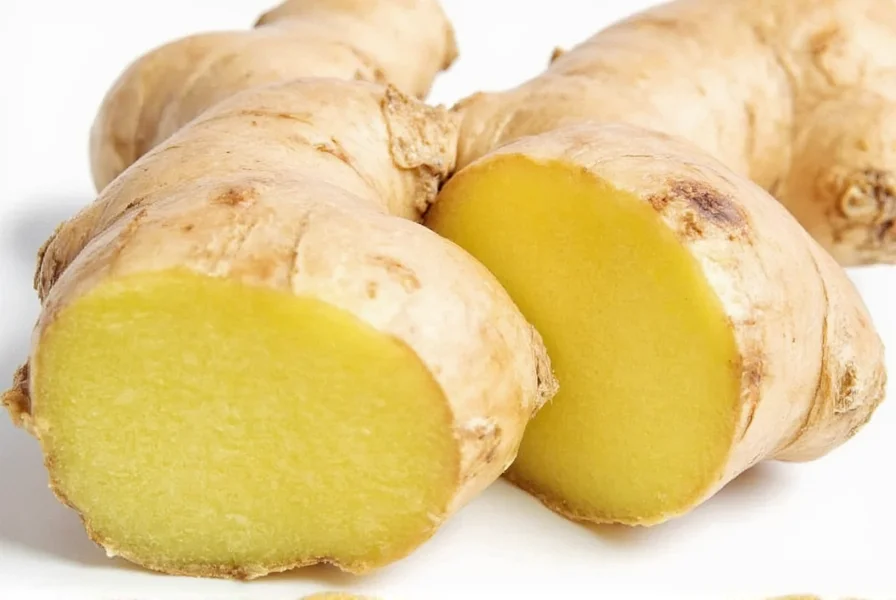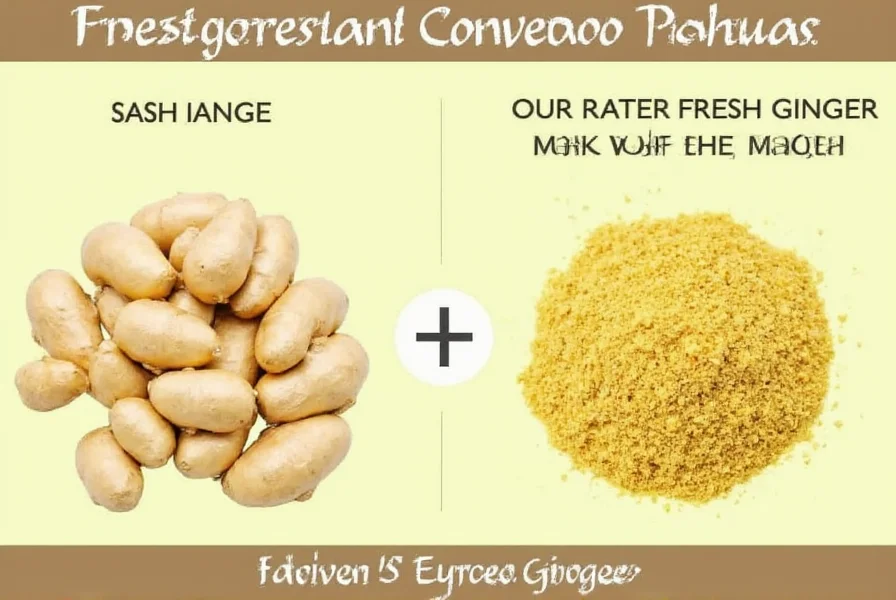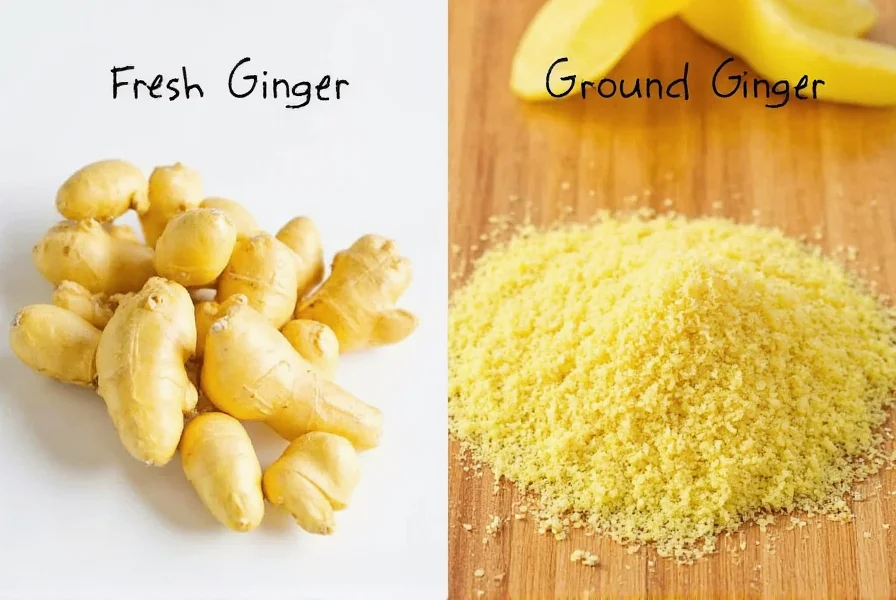The standard conversion is 1 tablespoon of fresh grated ginger equals 1/4 teaspoon of ground ginger. This 4:1 ratio accounts for the concentration difference as ground ginger loses moisture during the drying process, making it more potent by volume.
Understanding ginger substitutions is essential for home cooks and bakers who often find themselves needing to swap between fresh and ground forms. Whether you're following a family recipe that calls for one form while only having the other available, or experimenting with flavor profiles, knowing the precise conversion ensures your dishes maintain their intended taste and character.
Why Ginger Conversions Matter in Cooking
Ginger exists in two primary culinary forms: fresh rhizome and dried ground powder. These forms differ significantly in moisture content, flavor intensity, and chemical composition. Fresh ginger contains approximately 80% water, while ground ginger is dehydrated, concentrating its active compounds like gingerol and shogaol. This fundamental difference explains why you can't substitute these forms in equal amounts without affecting your recipe's outcome.
Professional chefs and food scientists agree that improper ginger substitution ranks among the top five spice measurement errors in home cooking. Getting this ratio wrong can lead to dishes that are either bland and under-spiced or overwhelmingly pungent and bitter.
Key Differences Between Fresh and Ground Ginger
Before diving into conversions, it's crucial to understand how these ginger forms differ:
| Characteristic | Fresh Ginger | Ground Ginger |
|---|---|---|
| Moisture Content | Approximately 80% | Nearly 0% (dehydrated) |
| Flavor Profile | Bright, citrusy, with sharp heat | Warmer, more earthy, less sharp |
| Active Compounds | Higher gingerol content | More shogaol (from dehydration) |
| Shelf Life | 2-3 weeks refrigerated | 2-3 years in airtight container |
| Best Uses | Stir-fries, fresh sauces, beverages | Baking, spice blends, dry rubs |
Detailed Conversion Guide for Ginger Substitutions
The standard 4:1 ratio (fresh to ground) serves as your foundation, but precise measurements vary by recipe type and desired flavor intensity:
- Liquids & Beverages: 1 tablespoon fresh grated ginger = 1/4 teaspoon ground ginger
- Baking: 1 tablespoon fresh = 1/8-1/4 teaspoon ground (use less for delicate cakes)
- Savory Dishes: 1 tablespoon fresh = 1/4 teaspoon ground (adjust to taste)
- Marinades: 1 tablespoon fresh = 1/6 teaspoon ground ginger
When substituting in reverse (ground for fresh), remember that ground ginger lacks the bright, citrusy notes of fresh ginger. For recipes where ginger is a featured flavor (like ginger snaps or fresh ginger tea), consider adding a squeeze of lemon juice to compensate for the missing brightness.
When Substitutions Work Best (and When They Don't)
Not all recipes tolerate ginger substitutions equally. Understanding which dishes are substitution-friendly can prevent culinary disasters:
Ideal for Substitution:
- Spice blends (curry powder, pumpkin spice)
- Dry rubs for meats
- Most baked goods (cookies, cakes, breads)
- Stews and braises with long cooking times
Poor Candidates for Substitution:
- Fresh ginger salads or slaws
- Ginger-based beverages (ginger tea, fresh juice)
- Dishes where ginger is the star ingredient
- Quick-cooking stir-fries (fresh ginger's volatile compounds dissipate)
Practical Tips for Successful Ginger Substitutions
Professional chefs recommend these techniques when converting between ginger forms:
- Start with less: Begin with 3/4 of the recommended ground ginger amount, then adjust to taste
- Reconstitute for moisture: When substituting ground for fresh in wet recipes, add 1/2 teaspoon water per 1/4 teaspoon ground ginger
- Enhance flavor: For ground ginger substitutions, add a pinch of black pepper to increase bioavailability of active compounds
- Consider freshness: Ground ginger loses potency over time; replace if older than 6 months for accurate conversions
- Taste as you go: Especially important when substituting in reverse (ground for fresh)
Food scientists note that the optimal substitution ratio can vary based on ginger variety. Jamaican ginger tends to be milder than Indian varieties, while Nigerian ginger is particularly potent. When possible, adjust conversions based on your specific ginger source.
Avoiding Common Ginger Substitution Mistakes
Even experienced cooks make these errors when substituting ginger forms:
- Equal volume substitution: Using 1:1 ratio creates overly strong flavors
- Ignoring recipe chemistry: In baking, excess moisture from fresh ginger can affect texture
- Not accounting for age: Older ground ginger requires slightly more for equivalent flavor
- Over-processing: Over-grating fresh ginger releases bitter compounds
- Incorrect storage: Storing ground ginger in humid environments reduces potency
For baking applications specifically, remember that ground ginger's finer particle size distributes more evenly through doughs and batters. When substituting fresh for ground, consider passing grated ginger through a fine mesh sieve to remove excess fibers that might affect texture.
Conclusion: Mastering Ginger Conversions
Understanding the precise relationship between fresh and ground ginger transforms your cooking accuracy and confidence. Remember the foundational 4:1 ratio (1 tablespoon fresh = 1/4 teaspoon ground), but remain flexible based on recipe requirements and personal taste preferences. The most successful cooks treat conversion guidelines as starting points, then adjust through careful tasting and experience. With this knowledge, you'll consistently achieve the perfect ginger balance in all your culinary creations, whether you're making spicy curries, delicate pastries, or refreshing beverages.


Can I use ground ginger instead of fresh in stir-fry?
Ground ginger works poorly in quick-cooking stir-fries as it lacks the bright, volatile compounds of fresh ginger that provide characteristic flavor. For stir-fries, fresh ginger is strongly preferred. If absolutely necessary, use 1/8 teaspoon ground ginger per tablespoon of fresh called for, added at the very end of cooking, but expect significantly different flavor results.
Does the conversion ratio change for ginger paste?
Yes, ginger paste (typically 85% ginger, 15% preservatives) requires different conversion. Use 1.5 teaspoons ginger paste to replace 1 tablespoon fresh grated ginger, or 1/2 teaspoon ginger paste to replace 1/4 teaspoon ground ginger. Always check your paste's concentration as formulations vary by brand.
Why does my recipe taste different even when I use the correct conversion?
Beyond simple conversion ratios, fresh and ground ginger have different flavor profiles. Fresh ginger offers brighter, more citrusy notes while ground ginger provides warmer, earthier tones. For recipes where ginger is prominent, consider adding 1/8 teaspoon lemon juice when substituting ground for fresh to approximate the missing brightness.
How do I adjust ginger measurements for dried vs fresh in baking?
In baking, use 1/8-1/6 teaspoon ground ginger per tablespoon of fresh ginger called for, as the dry heat of ovens intensifies ground ginger's flavor. For delicate cakes, start with the lower amount; for robust cookies like ginger snaps, use closer to 1/4 teaspoon. Remember that ground ginger distributes more evenly through batters than fresh grated ginger.
Does ginger's origin affect the conversion ratio?
Yes, ginger potency varies by region. Jamaican ginger tends to be milder (use 1/3 teaspoon ground per tablespoon fresh), while Nigerian ginger is particularly potent (use 1/5 teaspoon ground). Indian ginger falls in the middle (standard 1/4 teaspoon). When possible, adjust based on your specific ginger's intensity, starting with the standard ratio then fine-tuning to taste.











 浙公网安备
33010002000092号
浙公网安备
33010002000092号 浙B2-20120091-4
浙B2-20120091-4